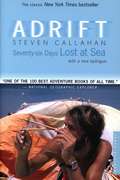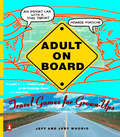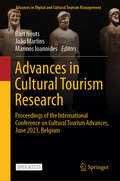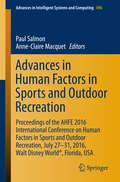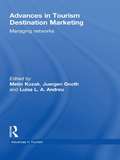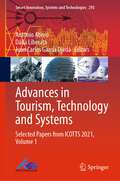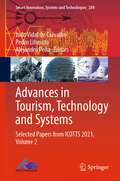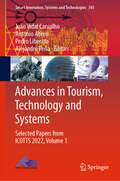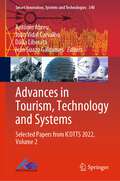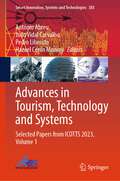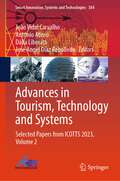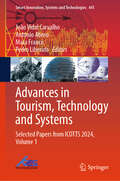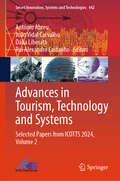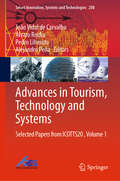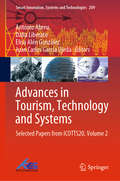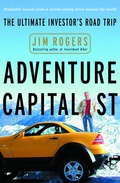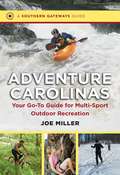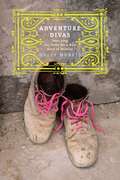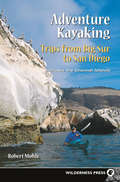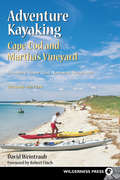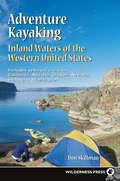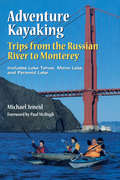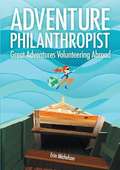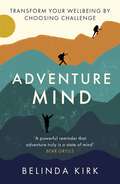- Table View
- List View
Adrift: Seventy-six Days Lost at Sea
by Steven CallahanBefore The Perfect Storm, before In the Heart of the Sea, Steven Callahan's dramatic tale of survival at sea was on the New York Times bestseller list for more than thirty-six weeks. In some ways the model for the new wave of adventure books, Adrift is an undeniable seafaring classic, a riveting firsthand account by the only man known to have survived more than a month alone at sea, fighting for his life in an inflatable raft after his small sloop capsized only six days out. "Utterly absorbing" (Newsweek), Adrift is a must-have for any adventure library.
Adult on Board: Travel Games for Grown-Ups
by Jeffrey J. Wuorio Judy WuorioFifty challenging games you can play while traveling, whether by car, train, bus, or plane--no equipment necessary! When staring at the back bumper of the car in front of you ceases to be amusing, you need Adult on Board: Travel Games for Grown-Ups, a fabulous collection of entertaining diversions that will beat the monotony of long trips. Included are games that expose the deepest secrets of your traveling companions, singing and rhyming games, memory games, guessing games, license-plate and travel-sign games, and games for wordplay wizards. Now getting there is all the fun.
Advances in Cultural Tourism Research: Proceedings of the International Conference on Cultural Tourism Advances, June 2023, Belgium (Advances in Digital and Cultural Tourism Management)
by Marinos Ioannides João Martins Bart NeutsThis open access book pertains to the "International Conference on Cultural Tourism Advances," held on June 27 and 28, 2023, at KU Leuven, Belgium. It focuses on advancing understanding of the sustainable development potential of cultural tourism by examining successful policy interventions, emerging cultural tourism trends, advancements in visitor management systems, new business and governance models, and the opportunities arising from ICT in the twenty-first century. This book presents recent key advances and their significant outcomes in the domain of European Cultural Tourism.
Advances in Human Factors in Sports and Outdoor Recreation: Proceedings of the AHFE 2016 International Conference on Human Factors in Sports and Outdoor Recreation, July 27-31, 2016, Walt Disney World®, Florida, USA (Advances in Intelligent Systems and Computing #496)
by Paul Salmon Anne-Claire MacquetThis book describes cutting-edge applications of human factors for sport and outdoor recreation disciplines and provides practical guidance on a range of methods for describing, representing, and evaluating human, team, and system performance in sports domains. Contributions in this book show how various human factors methods, applied historically in the complex safety critical domains, are suited to describing and understanding sports performance and sports injury prevention. The book discusses a wealth of methods for different purposes, such as data collection, task analysis (including cognitive task analysis), workload measurement, assessing situation awareness, performance assessment (including team performance assessment), decision making and cognition in sports, human error identification, and interface evaluation methods. With respect to other publications in human factors and ergonomics, which have been more focused on the biomechanical, physiological, environmental, and equipment-related aspects of sports performance, this book gives a special emphasis to research on analysis of individual and team sports, cognitive and social human factors, and covers both sports and outdoor recreation disciplines. Based on the AHFE 2016 International Conference on Human Factors in Sports and Outdoor Recreation, held on July 27-31, 2016, in Walt Disney World®, Florida, USA, this book provides readers with a timely survey of new methods that can be implemented during any sport or outdoor recreation event for analyzing and improving the performance and safety of both individuals and teams.
Advances in Tourism Destination Marketing: Managing Networks (Advances in Tourism)
by Metin Kozak Juergen Gnoth Luisa L. A AndreuThis volume provides original insight into the operational opportunities, challenges and constraints in managing Tourism Destination Marketing. It explores how the various tourist destination systems including tourist, places (as seen by the tourist), public and private tourism organisations and the social and physical environment can effectively communicate and co operate together at a profit for each. Advances in Destination Marketing offers a comprehensive review of a wide range of aspects related to marketing tourism products including networks in destinations, consumer experiences in destinations, destination branding, destination image, events in destinations and destination tourism products. Throughout the book a network analysis perspective is applied to offer alternative solutions of how each system can share network knowledge and system knowledge so profits can be created effectively and maximised. The exploration of new topics such as Destination Networks and Destination Branding as well as original international empirical research and case studies from well known researchers in the area, provides new thinking on Marketing Tourism Destinations. The relevance of the arguments and the salient conclusions are valuable in the study of an ever dynamic and burgeoning industry. This stimulating volume will be of interest to higher level students, academics, researchers within Tourism and practitioners in the industry.
Advances in Tourism, Technology and Systems: Selected Papers from ICOTTS 2021, Volume 1 (Smart Innovation, Systems and Technologies #293)
by António Abreu Dália Liberato Juan Carlos Garcia OjedaThis book features a collection of high-quality research papers presented at the International Conference on Tourism, Technology & Systems (ICOTTS 2021), held at the University of Cartagena, in Cartagena de Indias, Colombia, from 4 to 6 November 2021. The book is divided into two volumes, and it covers the areas of technology in tourism and the tourist experience, generations and technology in tourism, digital marketing applied to tourism and travel, mobile technologies applied to sustainable tourism, information technologies in tourism, digital transformation of tourism business, e-tourism and tourism 2.0, big data and management for travel and tourism, geotagging and tourist mobility, smart destinations, robotics in tourism, and information systems and technologies.
Advances in Tourism, Technology and Systems: Selected Papers from ICOTTS 2021, Volume 2 (Smart Innovation, Systems and Technologies #284)
by Pedro Liberato João Vidal de Carvalho Alejandro PeñaThis book features a collection of high-quality research papers presented at the International Conference on Tourism, Technology & Systems (ICOTTS 2021), held at the University of Cartagena, in Cartagena de Indias, Colombia, from 4 to 6 November 2021. The book is divided into two volumes, and it covers the areas of technology in tourism and the tourist experience, generations and technology in tourism, digital marketing applied to tourism and travel, mobile technologies applied to sustainable tourism, information technologies in tourism, digital transformation of tourism business, e-tourism and tourism 2.0, big data and management for travel and tourism, geotagging and tourist mobility, smart destinations, robotics in tourism, and information systems and technologies.
Advances in Tourism, Technology and Systems: Selected Papers from ICOTTS 2022, Volume 1 (Smart Innovation, Systems and Technologies #345)
by António Abreu Pedro Liberato Alejandro Peña João Vidal CarvalhoThis book features a collection of high-quality research papers presented at the International Conference on Tourism, Technology and Systems (ICOTTS 2022), held at University of Chile, Santiago de Chile, Chile, from 3 to 5 November 2022. The book is divided into two volumes, and it covers the areas of technology in tourism and the tourist experience, generations and technology in tourism, digital marketing applied to tourism and travel, mobile technologies applied to sustainable tourism, information technologies in tourism, digital transformation of tourism business, e-tourism and tourism 2.0, big data and management for travel and tourism, geotagging and tourist mobility, smart destinations, robotics in tourism, and information systems and technologies.
Advances in Tourism, Technology and Systems: Selected Papers from ICOTTS 2022, Volume 2 (Smart Innovation, Systems and Technologies #340)
by António Abreu Dália Liberato João Vidal Carvalho Iván Suazo GaldamesThis book features a collection of high-quality research papers presented at the International Conference on Tourism, Technology and Systems (ICOTTS 2022), held at University of Chile, Santiago de Chile, Chile, from 3 to 5 November 2022. The book is divided into two volumes, and it covers the areas of technology in tourism and the tourist experience, generations and technology in tourism, digital marketing applied to tourism and travel, mobile technologies applied to sustainable tourism, information technologies in tourism, digital transformation of tourism business, e-tourism and tourism 2.0, big data and management for travel and tourism, geotagging and tourist mobility, smart destinations, robotics in tourism, and information systems and technologies.
Advances in Tourism, Technology and Systems: Selected Papers from ICOTTS 2023, Volume 1 (Smart Innovation, Systems and Technologies #383)
by António Abreu Pedro Liberato João Vidal Carvalho Hazael Cerón MonroyThis book features a collection of high-quality research papers presented at the International Conference on Tourism, Technology and Systems (ICOTTS 2023), held at Anáhuac University, Bacalar, Mexico, from 2 to 4 November 2023. The book is divided into two volumes, and it covers the areas of technology in tourism and the tourist experience, generations and technology in tourism, digital marketing applied to tourism and travel, mobile technologies applied to sustainable tourism, information technologies in tourism, digital transformation of tourism business, e-tourism and tourism 2.0, big data and management for travel and tourism, geotagging and tourist mobility, smart destinations, robotics in tourism, and information systems and technologies.
Advances in Tourism, Technology and Systems: Selected Papers from ICOTTS 2023, Volume 2 (Smart Innovation, Systems and Technologies #384)
by António Abreu Dália Liberato João Vidal Carvalho José Angel Díaz RebolledoThis book features a collection of high-quality research papers presented at the International Conference on Tourism, Technology and Systems (ICOTTS 2023), held at Anáhuac University, Bacalar, Mexico, from 2 to 4 November 2023. The book is divided into two volumes, and it covers the areas of technology in tourism and the tourist experience, generations and technology in tourism, digital marketing applied to tourism and travel, mobile technologies applied to sustainable tourism, information technologies in tourism, digital transformation of tourism business, e-tourism and tourism 2.0, big data and management for travel and tourism, geotagging and tourist mobility, smart destinations, robotics in tourism, and information systems and technologies.
Advances in Tourism, Technology and Systems: Selected Papers from ICOTTS 2024, Volume 1 (Smart Innovation, Systems and Technologies #441)
by António Abreu Pedro Liberato João Vidal Carvalho Mara FrancoThis book features a collection of high-quality research papers presented at the International Conference on Tourism, Technology and Systems (ICOTTS 2024), held at held at University of Madeira, Portugal, from 30 to 31 October 2024. The book is divided into two volumes, and it covers the areas of technology in tourism and the tourist experience, generations and technology in tourism, digital marketing applied to tourism and travel, mobile technologies applied to sustainable tourism, information technologies in tourism, digital transformation of tourism business, e-tourism and tourism 2.0, big data and management for travel and tourism, geotagging and tourist mobility, smart destinations, robotics in tourism, and information systems and technologies.
Advances in Tourism, Technology and Systems: Selected Papers from ICOTTS 2024, Volume 2 (Smart Innovation, Systems and Technologies #442)
by António Abreu Dália Liberato João Vidal Carvalho Rui Alexandre CastanhoThis book features a collection of high-quality research papers presented at the International Conference on Tourism, Technology and Systems (ICOTTS 2024), held at held at University of Madeira, Portugal, from 30 to 31 October 2024. The book is divided into two volumes, and it covers the areas of technology in tourism and the tourist experience, generations and technology in tourism, digital marketing applied to tourism and travel, mobile technologies applied to sustainable tourism, information technologies in tourism, digital transformation of tourism business, e-tourism and tourism 2.0, big data and management for travel and tourism, geotagging and tourist mobility, smart destinations, robotics in tourism, and information systems and technologies.
Advances in Tourism, Technology and Systems: Selected Papers from ICOTTS20 , Volume 1 (Smart Innovation, Systems and Technologies #208)
by Álvaro Rocha Pedro Liberato João Vidal de Carvalho Alejandro PeñaThis book features a collection of high-quality research papers presented at the International Conference on Tourism, Technology & Systems (ICOTTS 2020), held at the University of Cartagena, in Cartagena de Indias, Colombia, from 29th to 31st October 2020. The book is divided into two volumes, and it covers the areas of technology in tourism and the tourist experience, generations and technology in tourism, digital marketing applied to tourism and travel, mobile technologies applied to sustainable tourism, information technologies in tourism, digital transformation of tourism business, e-tourism and tourism 2.0, big data and management for travel and tourism, geotagging and tourist mobility, smart destinations, robotics in tourism, and information systems and technologies.
Advances in Tourism, Technology and Systems: Selected Papers from ICOTTS20, Volume 2 (Smart Innovation, Systems and Technologies #209)
by António Abreu Dália Liberato Elisa Alén González Juan Carlos Garcia OjedaThis book features a collection of high-quality research papers presented at the International Conference on Tourism, Technology & Systems (ICOTTS 2020), held at the University of Cartagena, in Cartagena de Indias, Colombia, from 29th to 31st October 2020. The book is divided into two volumes, and it covers the areas of technology in tourism and the tourist experience, generations and technology in tourism, digital marketing applied to tourism and travel, mobile technologies applied to sustainable tourism, information technologies in tourism, digital transformation of tourism business, e-tourism and tourism 2.0, big data and management for travel and tourism, geotagging and tourist mobility, smart destinations, robotics in tourism, and information systems and technologies.
Adventure Capitalist: The Ultimate Investor's Road Trip
by Jim RogersBehind the wheel of a sunburst-yellow, custom-built Mercedes, Rogers and his fiancee, began their Adventure They drove through 116 countries, through war zones, deserts, jungles, and blizzards.
Adventure Capitalist: The Ultimate Road Trip
by Jim RogersDrive . . . and grow rich!The bestselling author of Investment Biker is back from the ultimate road trip: a three-year drive around the world that would ultimately set the Guinness record for the longest continuous car journey. In Adventure Capitalist, legendary investor Jim Rogers, dubbed "the Indiana Jones of finance" by Time magazine, proves that the best way to profit from the global situation is to see the world mile by mile. "While I have never patronized a prostitute," he writes, "I know that one can learn more about a country from speaking to the madam of a brothel or a black marketeer than from meeting a foreign minister."Behind the wheel of a sunburst-yellow, custom-built convertible Mercedes, Rogers and his fiancée, Paige Parker, began their "Millennium Adventure" on January 1, 1999, from Iceland. They traveled through 116 countries, including many where most have rarely ventured, such as Saudi Arabia, Myanmar, Angola, Sudan, Congo, Colombia, and East Timor. They drove through war zones, deserts, jungles, epidemics, and blizzards. They had many narrow escapes.They camped with nomads and camels in the western Sahara. They ate silkworms, iguanas, snakes, termites, guinea pigs, porcupines, crocodiles, and grasshoppers.Best of all, they saw the real world from the ground up--the only vantage point from which it can be truly understood--economically, politically, and socially.Here are just a few of the author's conclusions: * The new commodity bull market has started.* The twenty-first century will belong to China.* There is a dramatic shortage of women developing in Asia.* Pakistan is on the verge of disintegrating.* India, like many other large nations, will break into several countries.* The Euro is doomed to fail.* There are fortunes to be made in Angola.* Nongovernmental organizations (NGOs) are a scam.* Bolivia is a comer after decades of instability, thanks to gigantic amounts of natural gas.Adventure Capitalist is the most opinionated, sprawling, adventurous journey you're likely to take within the pages of a book--the perfect read for armchair adventurers, global investors, car enthusiasts, and anyone interested in seeing the world and understanding it as it really is.
Adventure Carolinas
by Joe MillerHave you ever wanted to take up a new outdoor sport but thought, "Not me" or "Where do I begin"? In this unique take-it-with-you guide, outdoors and fitness writer Joe Miller introduces you to sixteen adventure sports in the Carolinas, from water to land and through all four seasons. No matter where you live or what your level of expertise may be, he will lead you to opportunities that range from beginner level to peak experience and equip you with the tools and courage to get outdoors and enjoy nature in new and exciting ways. For each experience, Miller includes location, how to start, associated costs, organizations that can help you begin, physical and mental demands of each activity, and whether the activities are seasonal or competitive.Activities include mountain biking, flat-water and whitewater paddling, scuba diving, climbing, backcountry exploration, skiing, snowboarding and tubing, kiteboarding, hang gliding, and ziplining.
Adventure Divas: Searching the Globe for Women Who Are Changing the World
by Holly MorrisAfter years of working behind a desk, Holly Morris had finally had enough. So she quit her job and set out to prove that adventure is not just a vacation style but a philosophy of living and to find like-minded, risk-taking women around the globe. With modest backing, a small television crew, her spirited producer-mother, Jeannie, and a whole lot of chutzpah, Morris tracked down artists, activists, and politicos-women of action who are changing the rules and sometimes the world around them. In these pages, Morris brings to life the remarkable people and places she's encountered on the road while filming her PBS series Adventure Divas and other programs. We meet Assata Shakur, a former Black Panther and social activist and now a fugitive living in exile in Cuba; Kiran Bedi, New Delhi's chief of police, who revolutionized India's infamously brutal Tijar Jail with her humanitarian ethic; New Zealand pop star Hinewehi Mohi, a Maori who reinvigorates her native culture for a new generation; and Mokarrameh Ghanbari, a septuagenarian painter and rice farmer who lives in the tiny village of Darikandeh on the Caspian plains of Iran, where her creative talents run counter to the government's strict stance on art. Along the way, Morris herself becomes a certified Adventure Diva, as she hunts for wild boar with Penan tribesmen in the jungles of Borneo, climbs the Matterhorn short-roped to a salty fourth-generation Swiss guide, and memorably becomes the first woman ever to enter the traditional camel race of the Saharan oasis town of Timia. Intelligent, phenomenally funny, and chock-full of rich and telling details of place, Adventure Divas is a pro-woman chronicle for the twenty-first century. In a pilgrimage fueled by curiosity, ideology, and full-on estrogen power, Holly Morris has paved the way for all of us to discover our own diva within and set out on our own adventures.
Adventure Kayaking: Big Sur to San Diego
by Robert MohleA guide to 52 trips that have been selected by the author as the area's best kayaking spots. Choose from a wide variety of adventures, from day-long paddling expeditions along the spectacular Big Sur coast, to scenic tours of san Diego's historic harbor. Also journey out to the unique Channel Islands to explore mysterious sea caves or venture inland to catcha glimpse of the fascinating wildlife at some of the lakes and rivers of Southern California.
Adventure Kayaking: Cape Cod and Marthas
by David WeintraubDiscover what the Pilgrims missed when they moved to Plymouth after landing on Cape Cod. Explore the numerous bays, ponds, harbors, marshes, and tidal creeks of this New England treasure. In the expanded second edition of this classic book, author David Weintraub adds kayaking adventure off Martha Vineyard's shores. From one-hour trips to all-day excursions, kayakers of every skill level will find a route to explore.Trip descriptions, maps, launch sites, and driving directions, plus nearby historical and scenic attractions: this book is a must-have guide to the solitude and beauty of these regions.
Adventure Kayaking: Inland Waters
by Don SkillmanPaddle the premier inland waters of the Western States, where the scenery ranges from the fjord-like Ross Lake, nestled in the shadow of Washington State's Cascade Range, to the eroded, red-rocks of Utah's Lake Powell. Expert kayaker Don Skillman describes a range of varied trips to satisfy every type of kayaker.
Adventure Kayaking: Russian River Monterey
by Michael JeneidExplore by kayak the lagoons, bays, rivers, and lakes of Northern California, including the Russian River, San Francisco Bay, Monterey Bay, Lake Tahoe, and Donner Lake. Author Michael Jeneid hand-picked the most scenic and enjoyable kayaking areas for both beginners and experts. With this fact-filled book you can find the hidden kayak spots. The 24 trips include daytrips, overnight trips, easy paddles, options for canoers, and real adventurers for the advanced kayaker.
Adventure Philanthropist: Great Adventures Volunteering Abroad
by Erin MichelsonThe plan was there was no plan-visit all seven continents, see what happens. Erin Michelson is a high adventuress, who lives life on the edge. Giving up a successful business, her stake to a house, and all of her possessions,she decides to just take the money and run. Surviving swindlers and saints, she struggles to keep her eyes and heart open. Her escapades not only show us how best to tackle a minefield, how to bathe an elephant, and where to find a string of pearls, but also how to make a world of difference in the lives of those who are most vulnerable. For two years, she volunteers across the globe, searching for an authentic experience and the chance to reach out and leave the world, even just a small part of it, a better place. This is the life of an Adventure Philanthropist!
Adventure Revolution: The life-changing power of choosing challenge
by Belinda KirkFor the past twenty-five years, Belinda Kirk's professional life has revolved around adventure. She's seen it change people first hand: turning the timid into the confident, the addicted into the recovering, and the lost into the intentionally wandering. As a force for change, adventure can be powerful like few others.This book is about this transformational power, and the first to explore why adventure is essential to our wellbeing. From managing anxiety and overcoming fear, to finding self-worth and building interpersonal connections, to being happier, healthier, and more playful, ADVENTURE REVOLUTION draws lessons from more than two decades of experience leading groups into the wilderness around the globe. Illuminated with Belinda's personal narrative, her own research with modern hunter-gatherers, and the latest findings in neuroscience and behaviour, ADVENTURE REVOLUTION presents a compelling case for ditching the living room in favour of a longer, happier, and more adventurous life.
